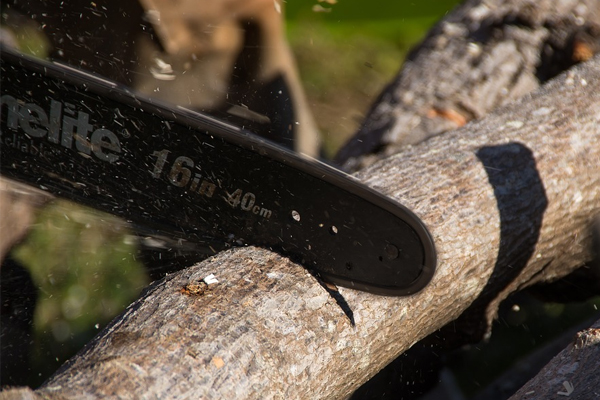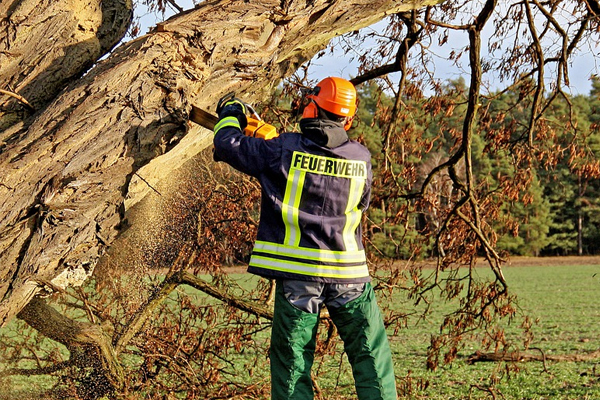
Chainsaws are the most powerful yet dangerous equipment that deserve our cautiousness and respect. It’s a powerful portable tool that cuts trees through a fast-rotating chain that rotates around the chainsaw blade or guide bar. Chainsaws can help you get done with tasks of pruning, climbing, felling, and bucking trees, but its features make it the most dangerous tool that needs handling with proper care and caution.
Every user must know how to use a chainsaw safely as anything that comes in contact with the bottom tip on the top half of the chainsaw blade changes the momentum to cut, and results in the chainsaw kickback against you. So, you must take all necessary precautions with additional protection.
The key to avoiding injury or a disaster is having proper knowledge on how to operate a chainsaw safely. If you have added this tool to your garden or yard equipment arsenal, you need to learn how to use it. Sure, you can understand from the manual instructions, but nothing can teach you better than an experienced user. We have years of experience in using a chainsaw and sharing the same knowledge with the new woodcutters.
In this article, we share all valuable insights into using a chainsaw in the safest, convenient, easy, and effective way. Every detail has been given in a crisp, concise and precise way for your easy understanding. So, let’s dive in.

Always use the right-sized chainsaw for your task. If you’re buying or renting a chainsaw, make sure you check the scope of the task that you can perform with the motor size they recommend, as the chainsaw blade is correlated to the engine horsepower. The general rule of thumb is choosing the chainsaw blade size two inches longer than the tree’s thickness that you’ll cut.
You can carry on light-duty tree cutting tasks with a 14-inch long chainsaw blade, whereas a 16-20 inches long chainsaw blade is ideal for medium-duty cutting of average and large-sized trees. Also, the longer the chainsaw blade, the harder it is to handle, so new users must choose a chainsaw blade less than 20 inches.
Here’s how you choose the right chainsaw:

Chainsaw safety should be your topmost concern as accidents can happen anytime, no matter how experienced or careful you are around a chainsaw. To bridge the gap between major injury and minor accident, you need to stay ready with the right set of protective equipment. It’s best not to be overconfident or too cool and leave things to chance and it’s better to start wearing safety gear when cutting.
You just wear clothing that fits you properly and gets safety gear items before starting or operating a chainsaw. Below are a few safety gear items that you must consider wearing when using a chainsaw machine.
Pro Tip:
One of the crucial chainsaw tips for beginners is ensuring it’s in the best condition before turning on the engine or starting cutting. Below is a checklist to help you prep your chainsaw.
Prep your safety gear from head to toe. Make sure that your chainsaw chain has good tension. You must tighten the tension to avoid any injury. You can check the chainsaw manual to know how to tighten the chain effectively. Use a wrench to tighten the chain while ensuring that it gets pulled slightly but not disengaged from the guide bar.

To start a chainsaw, we have already shared an article with in-depth insight, steps, tips and ways. You can click here to check how to turn on a chainsaw effectively. Here, you will get a summarized idea of starting a chainsaw in a simple and easy way.
However, starting an electric chainsaw involves fewer steps than a gas-powered chainsaw. Check our explicit article on this topic to know more.
You can use a chainsaw by placing it between your legs and keeping the back handle between your thighs while holding the front handle gently via your left hand. Until you find the engine fires, you need to use your right hand to pull the starter handle. You can use the choke, push and pull it until the chainsaw starts. Finally, release the chainsaw chain brake when needed.
Below are a few aspects related to and crucial to using a chainsaw. So, check them all.

You must hold your chainsaw with both hands while keeping it close and intact to your body. If the chainsaw engine is running, avoid changing your position or adjusting the chainsaw. You can turn the engine off when you need to pause and go for a warm start when you want to continue again.
No matter what purpose you’re using the chainsaw for, you need to follow some basic rules for handling and holding a chainsaw. For holding a chainsaw efficiently, keep good footing, maintain a good balance, and look for tripping hazards while ensuring not to overreach when the saw is running. Position the left hand gently around the front handle, including the thumb finger too.
Any chainsaw operation around the woods gets divided into three tasks: limbing, bucking and felling. Any professional can efficiently perform all these three tasks, whereas the novice will need a bit of insight and guidance.
Limbing is nothing but the process of removing the branches of any downed tree. Here, the chainsaw user can even work with a small-sized chainsaw blade. Bucking is the process of cutting the trunk of any downed tree to its length. Here, any medium-sized and medium-duty chainsaw blade can do the job. Lastly, felling is the process of cutting down any upright tree in an efficient and controlled way so that it falls where expected. Felling is mostly done for large trees, so any large-sized chainsaw blade for about 16-20 inches will do the job here.
As you know, physics taught us that every action results in an equal and opposite reaction. Chainsaw kickback is simply a demonstration of this law of physics. This type of chainsaw injury occurs when the bar tip’s top corner hits or triggers any object or is pinched.
When dealing with kickback and pinching, the energy in the chainsaw enforces the blade up and towards the user's direction with great speed and power, giving less time for the user to react. First, you have to deal with kickback by never engaging your chainsaw with the upper corner of the guide bar and staying aware of the bar tip’s position all the time.
You can also practice efficient operating techniques with a balanced stance, firm and steady hold and grip on the chainsaw, and a sharp and tensioned chain. You must stay alert for scenarios when the bar can get pinched by the cut wood.
‘Pinching the guide bar’ is a good transition for the direct pressures happening in the log, limb, or erect tree that depicts the approach of cutting by the chainsaw operator. These pressures, mainly compression or tension, vary in degrees for every log, limb or tree. Tension causes the wood fibres to stretch apart while the groove in the wood made through the chainsaw will widen with the deepening of the cut. Compression is what causes the groove to narrow with the deepening of the cut. If you don’t stay alert, this compression will pinch the bar and aggressively stop the chain’s spinning motion.
You must take a few moments to think before cutting to resolve the solution. You can determine the slight opening or closing of the kerf when you deepen the cut. The kerf opening indicates the full speed ahead, whereas a kerf starting to close indicates you pull the chainsaw out and cut from another side of the tree.
Chainsaw maintenance is crucial for extending your chainsaw’s durability and lifetime while ensuring its safer and easier use. Here’s how to maintain a chainsaw once you’re done cutting:
You must ensure that the chain shows no movement while the chainsaw is idle. Before performing any maintenance or refueling task, turn off your chainsaw machine. Wear the best quality personal protective equipment with safety gloves, mitts, helmets, pads, and more.
Yes, it’s vital to wear gloves while using chainsaws. You should always wear protective gloves as a mandatory accessory any time before you decide to fire up the chainsaw.
There are several dangers and risks involved with the use of chainsaws. The dangers are kickback, risk of cutting yourself, hearing damage, vibrations, eye injury, head injuries, crushing under a falling tree, back injuries, etc.
Remember that using a chainsaw needs physical strength and endurance as it can be a tiring experience. You must take breaks while using chainsaws during any operation. You can leave the remaining job for some other day if you become too tired. Also, keep your focus and concentration on the task only or you can end up with an injury. Your confidence will develop with practice and experience, so keep using chainsaws safely.